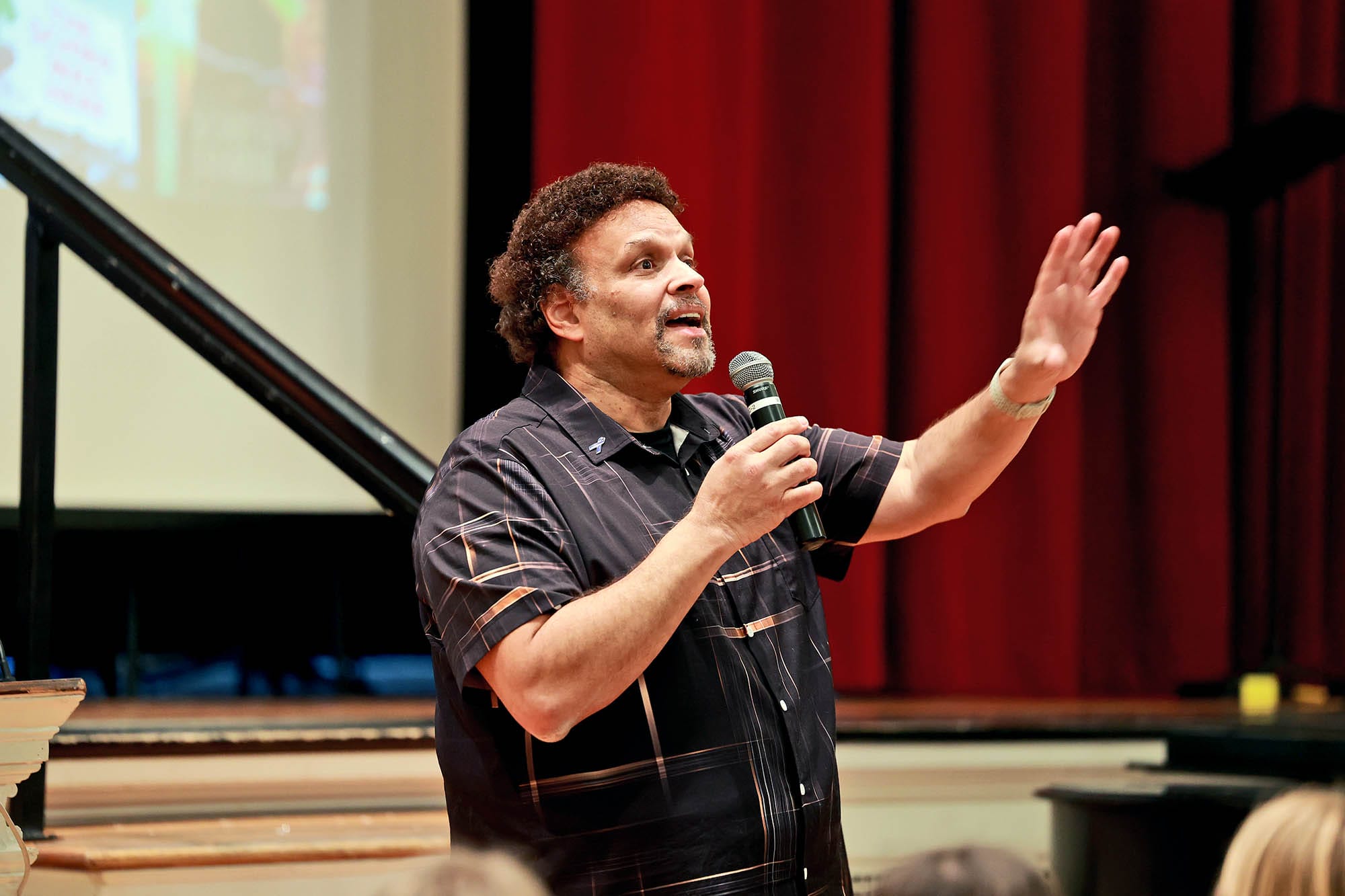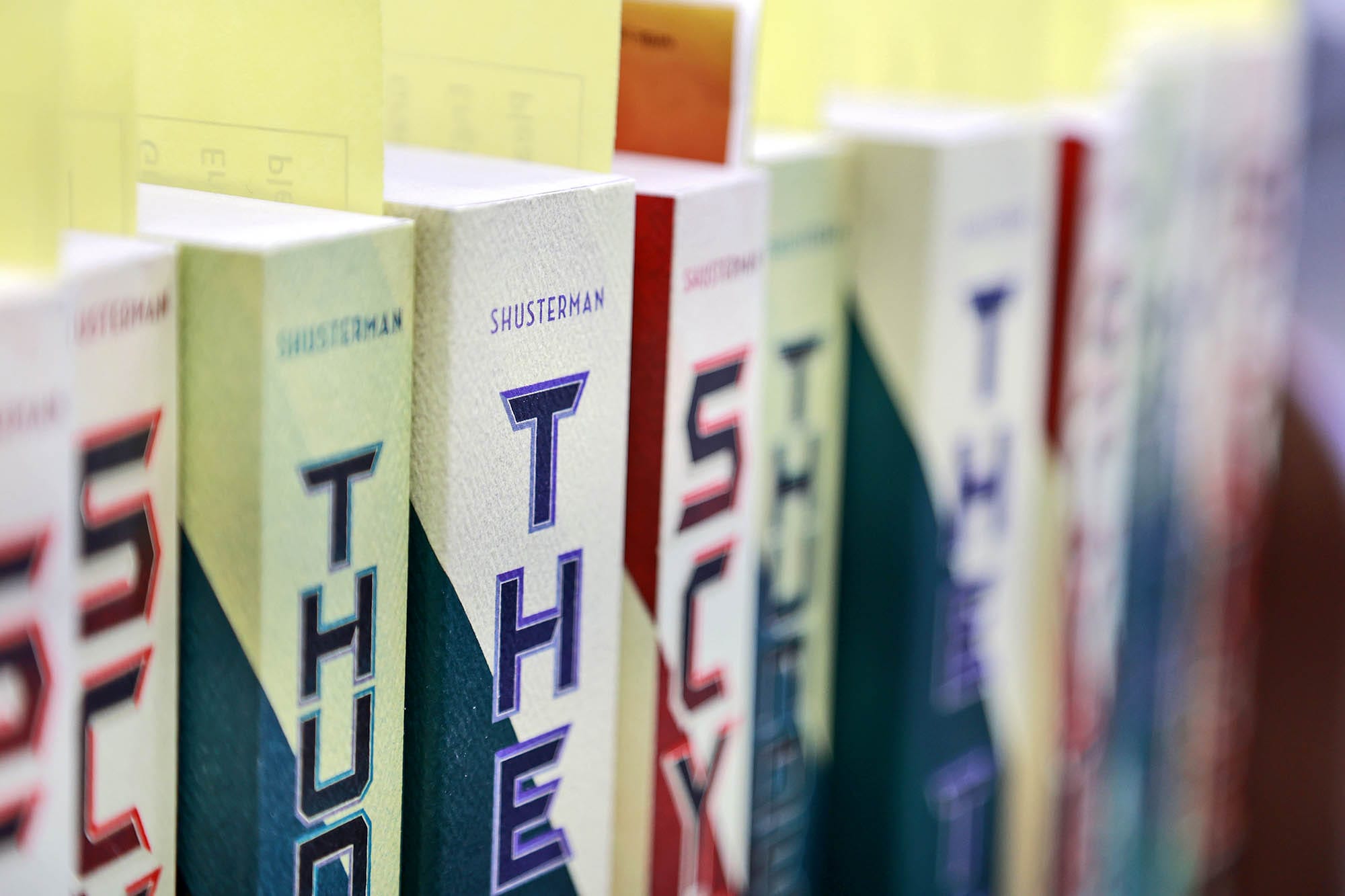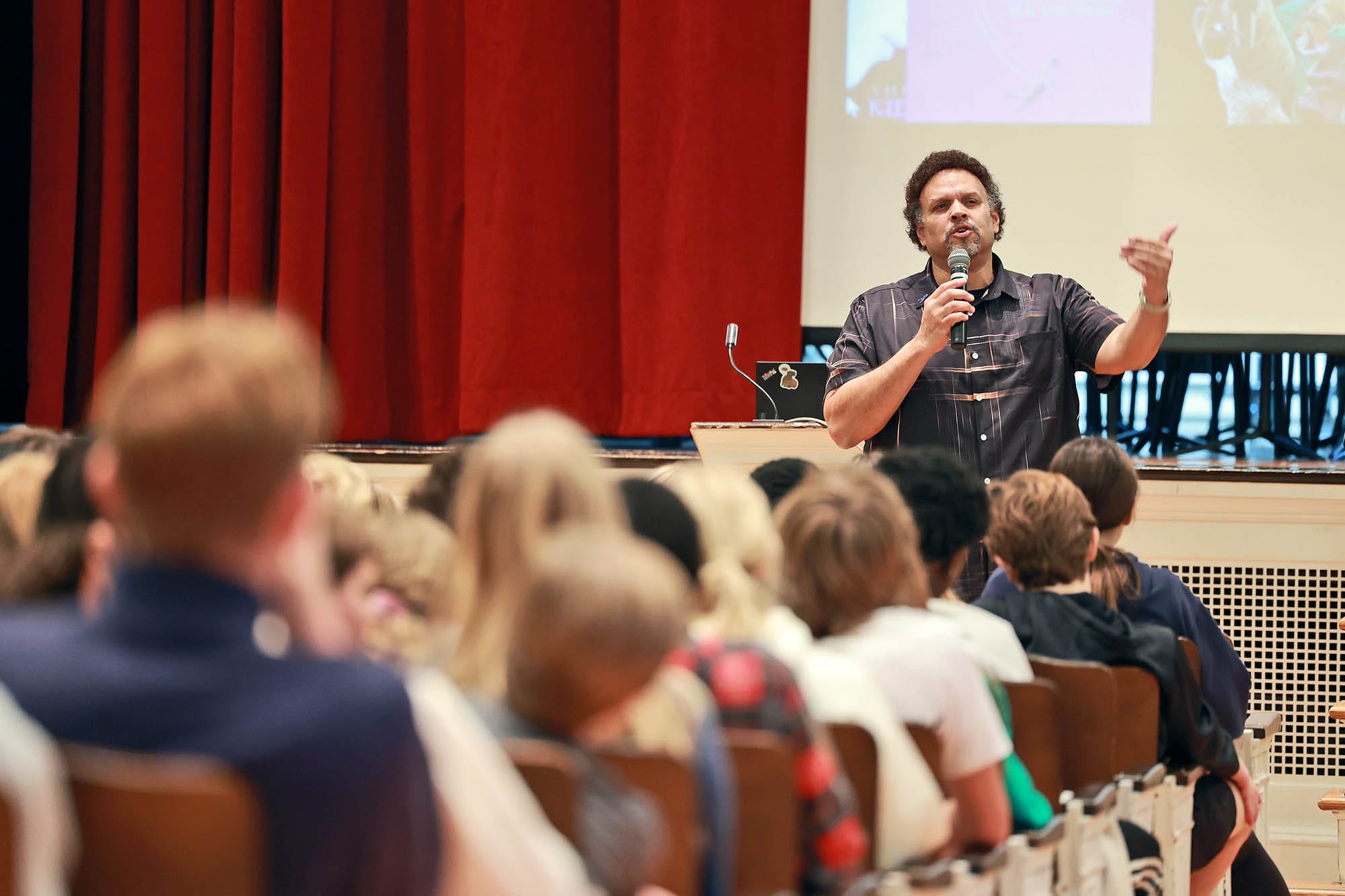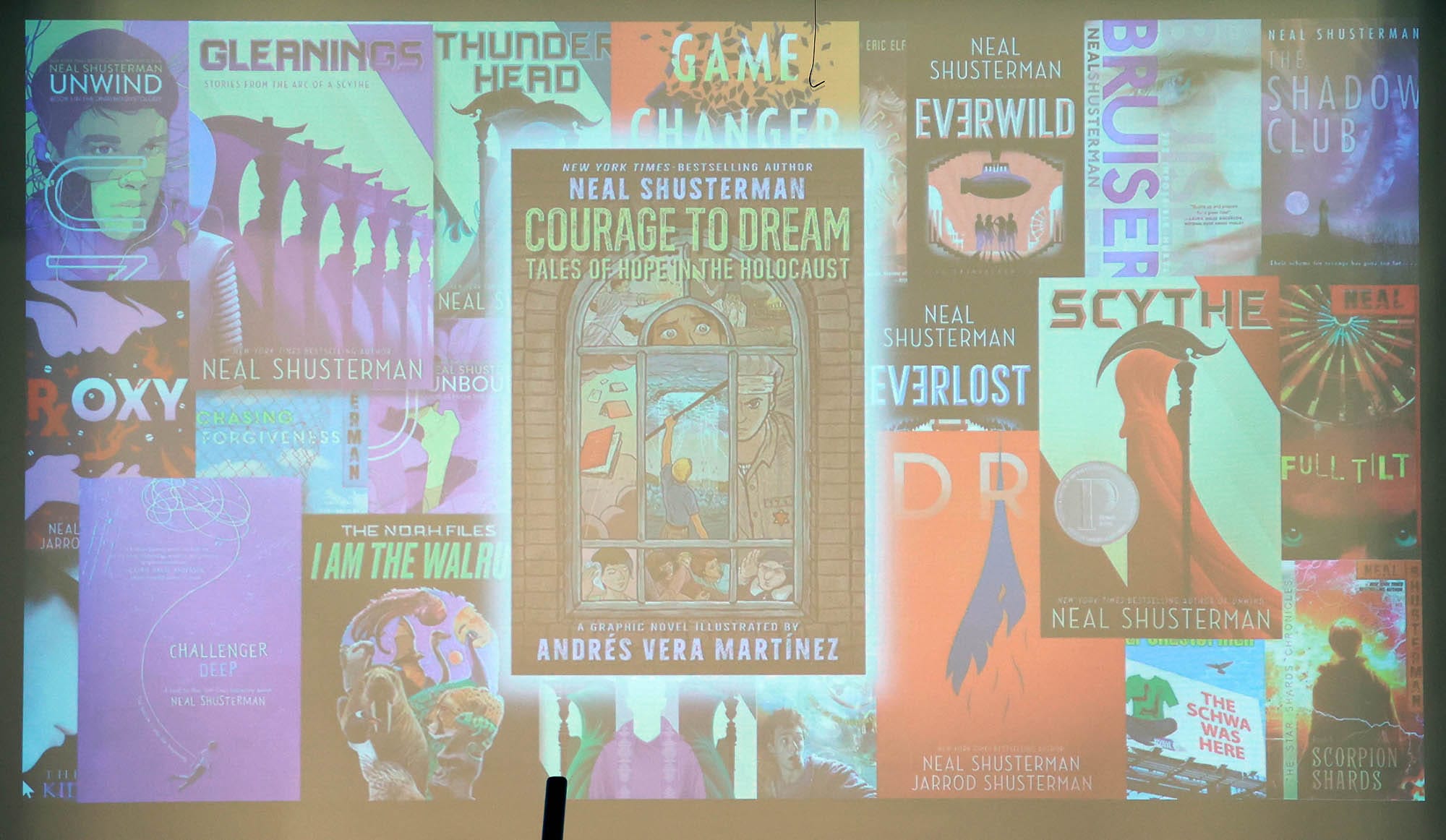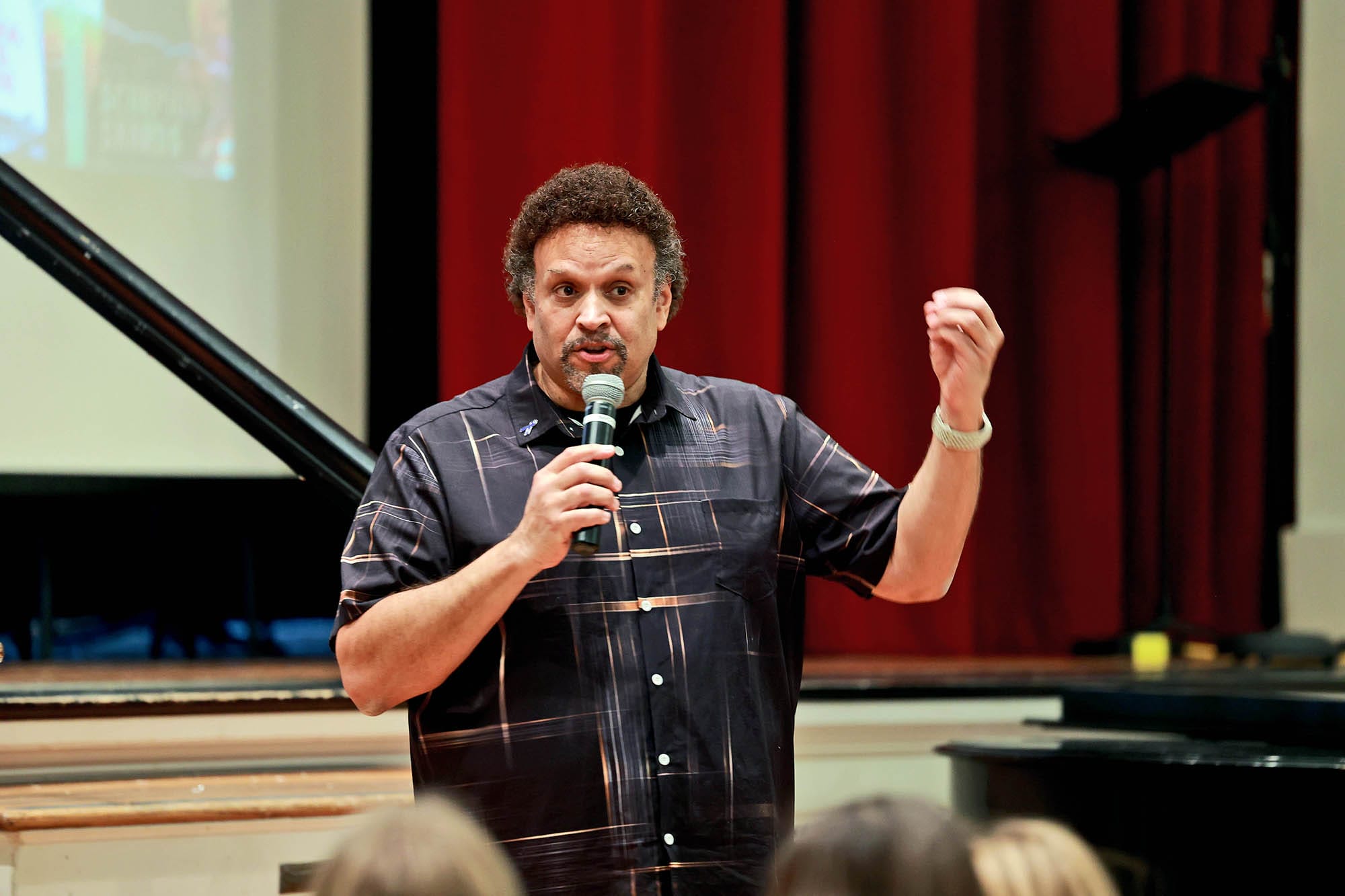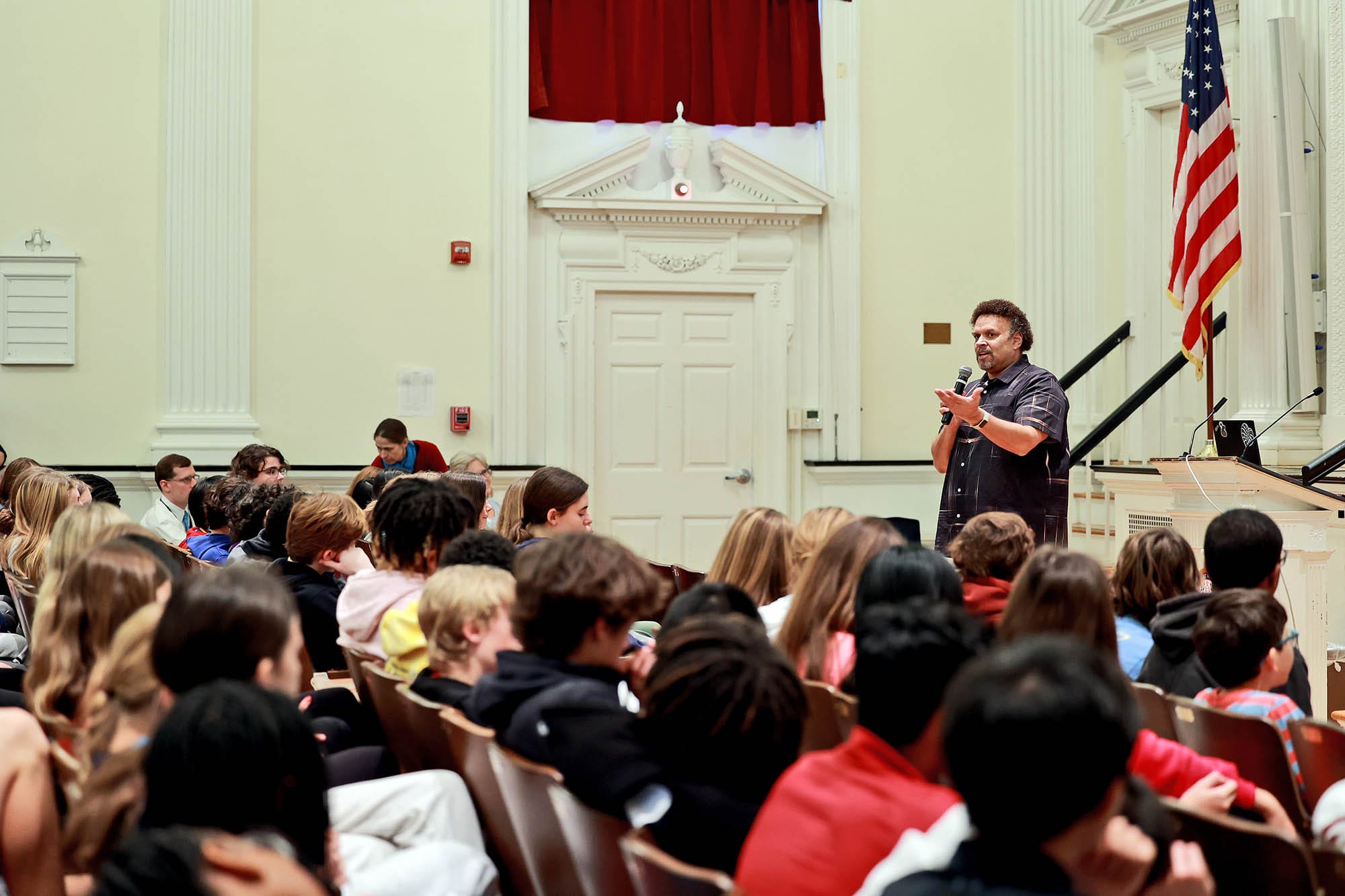Seventh- and eighth-grade students had a special guest visitor last week: author Neal Shusterman stopped by Eliot Chapel to speak about his books and the craft of writing. His latest book is Courage to Dream: Tales of Hope in the Holocaust, a graphic novel. “Having Mr. Shusterman speak about this book dovetails nicely with the seventh- and eighth-grade history and English units,” said Middle School Librarian Bethany Kavanaugh. Seventh-grade history classes are learning about the Holocaust in January and will visit our local Holocaust museum. Eighth-grade students visited the Holocaust museum in November and studied Night by Elie Wiesel in English class.
After the students assembled in Eliot Chapel, Kavanaugh introduced Shusterman. She said, “I am beyond ecstatic to have all of you here and to be able to introduce our guest speaker today, Neal Shusterman, to the inspiration and location for Fulcrum City. Mr. Shusterman’s amazing writing journey is a perfect example of what it means to blend complex narratives and themes but still be able to create gripping stories and worlds that stick with readers forever. He’s written books that span multiple genres and age groups and has shown that he can keep anyone on the edge of their seats, unable to put the book down.
From dystopian worlds that make us question our own views of society to deep explorations of life, death, and everything in between, Mr. Shusterman’s books are the definition of peak storytelling that fuels our imaginations but also makes us take time to reflect and process what we just read.
That’s enough of me talking, and I am so excited to hear more about his new graphic novel, and I know all of you are as well. Take a moment to prepare to question, reflect, and experience the magic. Please join me in welcoming exceptional author Neal Shusterman to MICDS.”
Shusterman announced that he was there to talk about “reading and writing and everything that goes with it.” He shared that he’s been working on Courage to Dream for 13 years, and it is close to his heart. The book features five stories about the Holocaust. “I wanted to write this book because I was starting to get very frustrated with people who are Holocaust deniers,” he said. “People want to pretend it never happened, that about 12 million people were never murdered by the Nazis. As an American Jew, I wanted to shout from the rooftops about it.”
Shusterman tends to write stories where he “bends reality” and admits that they might be considered science fiction, fantasy, or surrealistic. “I have a tendency to twist reality,” he said, “but how do you take a reality as hard and stark as the Holocaust and add fantasy?” He knew that he was walking a fine line: too much fantasy, and it becomes fodder for denials about the reality of the tragedy. He wrote a short story early in his career called He Opens a Window, and it was his first attempt to tackle the subject. The story is set in Nazi Germany and is about three sisters hidden in a room in a woman’s house. The woman told them, “You must never look out the window, never open the curtains. Someone might see you and report you to the Nazis, who will take you to their death camps.” A light shines through the window one day and the girls can’t resist: they peek out and see another world, a fulfillment of their wish to escape the atrocities of Nazi Germany. Soon after, the Nazis discover their hiding place and they are forced to escape through the window to another world. Ultimately, it’s a story about hope, said Shusterman. “There was some hope. There were people who risked their lives to protect Jews.”
After writing the story, Shusterman realized that it lent itself to visual representation. “The whole idea of a window, looking out into another world, is a very visual story,” he told the students. “What if I did a graphic novel? Writing a graphic novel is like writing a movie script, which I do. It’s writing for still frames rather than for a motion picture, but still very similar.” While he was working on it, he had ideas for other stories that included the resistance, the Jews who escaped, and others who hid. “What if I did a collection of different stories showing different aspects, each with a fantasy twist that would add to the story, add to that sense of hope, and open up the story that might not be there with a straight, realistic story?” he asked himself. He began to explore folklore and used those characters to fight alongside the real people of his stories. One of the pieces in Courage to Dream is about the people of Denmark collaborating to protect their Jewish brothers and sisters. “It’s a testimony to the power of compassion over hatred, of hope over atrocity,” he said. “I took the reality and tweaked it just a little bit to create the story.”
Ultimately, Shusterman feels his writing is a tool.
“I want it to be a beacon to shine light into the dark corners where hatred lies. It’s always there and finds new places and new voices, but beacons can chase it away, and we have to be vigilant about chasing it away, be the light in the face of darkness.”
He shared about how he and his publisher worked together to find just the right artist to illustrate Courage to Dream. Ultimately, they chose Andres Vera Martinez, who Shusterman said is grounded in reality but also has the imagination to bring those moments of fantasy to life. “Some pages still give me chills. The landbridge of sunken ships, the images through the window of the other world, are brilliant and stunningly beautiful. The artwork and stories came together to create something greater than the sum of its parts,” he said.
He opened the floor to questions, and our student readers and writers eagerly queried a variety of topics.
What is your favorite genre to write and why?
“None at all. I’m a genre buster; a bit of a disrupter. If someone says, ‘This is how you write something or fit in this genre,’ I want to defy it and break the genre. I approach it with the goal of breaking the genre.” He talked about how there is so much dystopian fiction in middle-grade books these days. “The world has gone wrong, and it’s always up to the protagonists—who are always teenagers—to fix it. I’ve seen that. What I want to see is the world gone right. There’s no such thing as perfect, but what if we try to get to our optimal society? There are a lot of scary stories about AI. All these stories are about what happens when AI goes wrong, and tries to destroy us. What happens with AI goes right? I talked to computer programmers to find out what they are hoping for, what’s the best case scenario. The result was my book Thunderhead. The goal of AI is all the knowledge and wisdom and none of our human flaws. It doesn’t take over the world. We give it the world to take because it’s so much better than running the world than we are.”
What is your favorite book you’ve ever written?
“Your books are like your children; you can’t pick one. You love them all.
Scythe is a favorite because I love the world-building. The Shadow Club was my first book, so that’s very special. I co-wrote Dry with my son, Jarrod, and that was such a bonding experience. Challenger Deep was inspired by my other son’s experience with mental illness, so that’s very special.”
How much do you research before you write a book?
“I can’t say how much time because much of my research takes place during the writing, so it’s hard to say. If I have a question while writing, I have to research it before I can move forward.
For Challenger Deep, I didn’t have to do research because I lived that with my family, and I didn’t want my story to be influenced by other stories.”
What gives you the inspiration to write?
“Usually, when I write a story, four things have to happen. It needs to be a cool idea, an original idea I haven’t seen before, an idea that is universal and relatable regardless of language, culture, and the time period you live in, and a story that screams to be told, that keeps me awake at night. I have to write it; I have no choice. Scythe was banging at my door, insisting to be written, and I didn’t know why until after it was done. I was speaking at a big conference for teachers and librarians on a panel with other authors, and I had my talking points. A question the moderator asked was, ‘What was going on in your life when you came up with the story?’ I hadn’t thought about it. So I went back through time to 2013 when I came up with the idea, and I had a grand realization: my mom had had a stroke, a very serious stroke, that left her in a locked-in state. She had no control over her body, couldn’t talk, couldn’t eat. The only way she could communicate was by blinking. Sometimes, she responded to questions, and she was in that state for over a year. The doctor told me and my dad that maybe it was time to think about letting her go. There was no quality of life, and we made the difficult decision to turn off the feeding tube. The doctor said she’d pass away within the week with no feeding tube. She lasted a month and passed away on her birthday. There is no easy way to lose a parent, but it’s part of the circle of life, and we all have to face it. Her last day was life-changing for me. The nurse was with her 24/7 in my house on hospice, waking me and my father at five in the morning to say it was almost time. We came downstairs, and I held my mother’s hand, he held the other hand, we stroked her head, and I told her it was ok to go. Finally, the nurse took the stethoscope away from her heart and said she was gone. The idea of being held by the two people you love the most is not the worst way to go. The next story I wrote was about death coming with love and compassion.
“As writers, we don’t know what compels us to tell stories, but there’s always something. That’s what makes the story relatable.”
Which book would you recommend to read?
“I recommend reading all the books! It depends on what you like. Everyone likes something different. If you’re a nonreader, then Full Tilt. It brings people to read. I would also suggest Unwind and Scythe, but everyone likes something different. I don’t write the same story over and over again; I try to write something different every time, so there are stories for everybody.”
When did you become a storyteller?
“It really happened when I was 18, and I got a job as a counselor at a summer camp. I became known as the camp storyteller. I started making up my own stories, and those were the ones the campers really liked. There’s a lot of power in storytelling. Kids would say, ‘You should write it into a book.’ My first and second stories didn’t sell. The third one did, and that’s what got me started. I love verbally telling stories, and I still get to do it when I come to speak in schools. I love that part of being an author. Connecting with the audience, with readers. The readers make me want to do what I do.”
What’s your favorite genre to read?
“I don’t think in terms of genre. I usually ask a librarian or bookseller, ‘What book should I read this year? What’s your favorite book?’ It’s usually not a best seller or one I’ve heard of. Those are the ones I like most.”
Why did you want to write a graphic novel instead of just another novel?
“I wanted to do something new. That’s how you grow as a writer: do something new and break the bounds of what you’ve already done. The second you start to write the same thing over and over again, that’s when it becomes boring. I want to do something new and something better.”
Thank you to Mr. Neal Shusterman for spending time with our seventh- and eighth-grade students and for signing all those books! We are huge fans!
